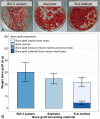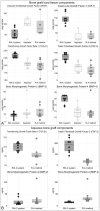An in vivo study to investigate an original intramedullary bone graft harvesting technology
- PMID: 37715198
- PMCID: PMC10503043
- DOI: 10.1186/s40001-023-01328-8
An in vivo study to investigate an original intramedullary bone graft harvesting technology
Abstract
Background: Harvesting bone graft (BG) from the intramedullary canal to treat bone defects is largely conducted using the Reamer-Irrigator-Aspirator (RIA) system. The RIA system uses irrigation fluid during harvesting, which may result in washout of osteoinductive factors. Here, we propose a new harvesting technology dedicated to improving BG collection without the potential washout effect of osteoinductive factors associated with irrigation fluid. This novel technology involves the conceptual approach of first aspirating the bone marrow (BM) with a novel aspirator prototype, followed by reaming with standard reamers and collecting the bone chips with the aspirator (reaming-aspiration method, R-A method). The aim of this study was to assess the harvesting efficacy and osteoinductive profile of the BG harvested with RIA 2 system (RIA 2 group) compared to the novel harvesting concept (aspirator + R-A method, ARA group).
Methods: Pre-planning computed tomography (CT) imaging was conducted on 16 sheep to determine the femoral isthmus canal diameter. In this non-recovery study, sheep were divided into two groups: RIA 2 group (n = 8) and ARA group (n = 8). We measured BG weight collected from left femur and determined femoral cortical bone volume reduction in postoperative CT imaging. Growth factor and inflammatory cytokine amounts of the BGs were quantified using enzyme-linked immunosorbent assay (ELISA) methods.
Results: The use of the stand-alone novel aspirator in BM collection, and in harvesting BG when the aspirator is used in conjunction with sequential reaming (R-A method) was proven feasible. ELISA results showed that the collected BG contained relevant amounts of growth factors and inflammatory cytokines in both the RIA 2 and the ARA group.
Conclusions: Here, we present the first results of an innovative concept for harvesting intramedullary BG. It is a prototype of a novel aspirator technology that enables the stepwise harvesting of first BM and subsequent bone chips from the intramedullary canal of long bones. Both the BG collected with the RIA 2 system and the aspirator prototype had the capacity to preserve the BG's osteoinductive microenvironment. Future in vivo studies are required to confirm the bone regenerative capacity of BG harvested with the innovative harvesting technology.
Keywords: Bone graft; Cytokines; Growth factors; Harvesting.
© 2023. BioMed Central Ltd., part of Springer Nature.
Conflict of interest statement
D.N.S., P.K., and F.H. received consulting fees from Stryker. All other authors declare that the research leading to this study was conducted in the absence of any commercial or financial relationships that could be construed as a potential conflict of interest.
Figures






References
-
- Wenisch S, Trinkaus K, Hild A, Hose D, Herde K, Heiss C, et al. Human reaming debris: a source of multipotent stem cells. Bone. 2005;36(1):74–83. - PubMed
-
- Schmidt AH. Autologous bone graft: Is it still the gold standard? Injury. 2021;52(Suppl 2):S18–s22. - PubMed
-
- Schmidt AH. Autologous bone graft: Is it still the gold standard? Injury. 2021;52:S18–S22. - PubMed
-
- Stanovici J, Le Nail LR, Brennan MA, Vidal L, Trichet V, Rosset P, et al. Bone regeneration strategies with bone marrow stromal cells in orthopaedic surgery. Current Res Transl Med. 2016;64(2):83–90. - PubMed
MeSH terms
Substances
LinkOut - more resources
Full Text Sources
Medical

